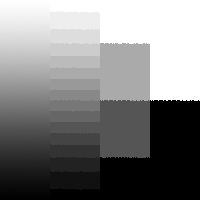Can My Computer Really Display "Millions" of Colors?
Not really. In theory most computers can produce about 16.777 million different color combinations for display on the monitor. This number comes from the fact that each of the red, green, and blue primary channels used to control the computer display is controlled with an 8-bit number. An 8-bit number can have 256 possible levels ranging from 0 to 255. Zero is used to represent the color channel being fully turned off while 255 represents fully turned on. Thus a black color is encoded with 0,0,0 for R,G,B while white is encoded with 255,255,255. Since there are 256 possible levels of red, green, and blue and each is independent of the other, then there are 256 x 256 x 256 different color combinations that the computer can theoretically display. 256 x 256 x 256 = 16.777 million and that is where the term "millions of colors" used for computer displays came from.
However, theory and practice are different. First of all, no computer displays have 16.777 million pixels, so it is not possible to display all of those color combinations at the same time. More typical displays have about one or two million pixels and therefore it impossible to display more than that many colors, even theoretically. Secondly, many of those color code combinations do not produce distinct colors. For example many of the color codes that are close to zero would all look black to us, so it is not correct to suggest that they are all separate colors when we cannot possibly tell them apart. (And remember, color is a perception.)
Realistically, for most images and typical viewing conditions, an encoding with 5- or 6-bits per channel is indistinguishable from one with 8-bits per channel. That means that an image with around 33 thousand color combinations is usually indistinguishable from one with all 16.777 million possible color combinations. Therefore it is more realistic to say that the computer can really display only thousands of colors, not millions.
![]()
Explore the NEXT TOPIC at this level.
Explore the NEXT LEVEL on this topic.
Ever wonder ... What color is the moon?
Updated: Apr. 30, 2012

